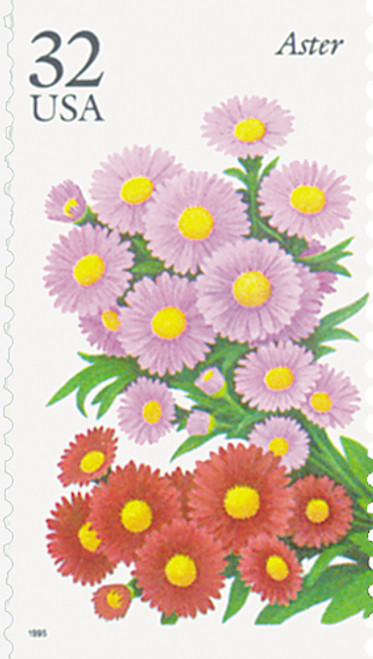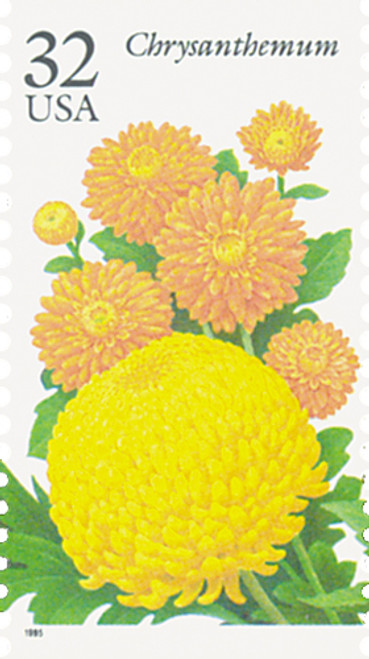
# 2996 FDC - 1995 32c Fall Garden Flowers: Hydrangea
U.S. #2996
1995 Hydrangea
Fall Garden Flowers
- Third issue in the Garden Flowers Series
Stamp Category: Commemorative
Series: Garden Flowers
Value: 32¢ First-Class postage rate
First Day of Issue: September 19, 1995
First Day City(s): Encinitas, California
Quantity Issued (if known): 200,000,000
Printed by: Bureau of Printing and Engraving
Printing Method: Offset (flower images) Intaglio (type)
Format: Booklet of 20 stamps. Four booklet panes of 5 stamp strips.
Perforations: 10.9
Why the stamp was issued: This stamp was issued as part of the third installment of the Garden Flower Series. This stamp fulfilled the then-current first-class postage rate of 32¢.
First Day City: The ceremony was held at the Quail Botanical Gardens in Encinitas, California.
Unusual fact about this stamp: There were some customers who questioned the inclusion of the hydrangea into the set of fall flowers. Some said their hydrangea bloomed in late spring or early summer. Elizabeth A. Altobell, the project manager, said “It’s not scientific. It’s meant to be more for mass-market appeal, as opposed to botanical.”
About the Garden Flowers Series: On May 15, 1993, the USPS issued the first installment in the Garden Flower Series, which would honor flowers that bloom in each of the four seasons.
This series was born out of the 1992 Wildflowers issue. That project had begun when the USPS asked an artist to produce color sketches of a group of garden flowers. Instead, the artist gave the USPS illustrations of wildflowers. The USPS liked them so much, it decided to create a 50-stamp pane, showing wildflowers that can be found in each state.
The USPS still liked the garden flowers idea. Part of the push behind these stamps had come from the sale of stamps in supermarkets and other retailers. People said they wanted “bright, pretty American stamps.” The USPS decided flower booklets would please the public. It ran TV commercials and full-page advertisements in stamp publications announcing “The flowers are in bloom at your post office. Buy them while they last!” and “Pick up a bunch.” The Garden Flowers booklet was the first to be produced on the new Goebel booklet machine, which was the first to print multicolor covers.
The stamps were issued on May 15, 1993, in Spokane, Washington at the 55th annual Spokane Lilac Festival and International Lilac Society Convention. Though not announced at the time, these stamps were to be the first in a new series of seasonal flower booklets.
The second booklet in the series was issued on April 28, 1994, at the Greater Cincinnati, Ohio, Flower and Garden Show. It featured summer garden flowers.
The third booklet in the series was issued on September 19, 1995, at the Quail Botanical Gardens in Encinitas, California. This booklet featured fall blooms.
The final booklet in the series was issued on January 19, 1996, in Kennett Square, Pennsylvania. The flowers selected for these stamps are the hardiest plants that grow anywhere in the country that experiences winter weather.
History the stamp represents:
Hydrangea
The flowering shrubs of the hydrangea have beautified many homes with large, showy, snowball-like flowers. These airy snowballs, really clusters of hundreds of tiny flowers, have been popular so long they’re regarded as old-fashioned flowers. Some varieties reach heights of 30 feet while other varieties are superb for landscaping. Hydrangea are native to North and South America, China, and Japan; thus, they arrived in Europe from both directions.
One particular variety, the hydrangea hortensis, has an intriguing story. By 1768, several Europeans had already circled the globe – but no Frenchman had. Louis XV ordered Louis de Bougainville to do so and to search for interesting plants enroute. The elderly botanist Commerson and his young assistant Baret accompanied Bougainville.
After a kidnapping attempt by a Tahitian chieftain, Commerson learned Baret was a woman named Hortense. He was so embarrassed, he never returned home. Hortense eventually returned to France with pink hydrangea from Japan. The shrubs, belonging to the French crown, were duly handed over to Empress Josephine. Planted in iron-enriched soil, they produced the blue flowers later named after Hortense.
U.S. #2996
1995 Hydrangea
Fall Garden Flowers
- Third issue in the Garden Flowers Series
Stamp Category: Commemorative
Series: Garden Flowers
Value: 32¢ First-Class postage rate
First Day of Issue: September 19, 1995
First Day City(s): Encinitas, California
Quantity Issued (if known): 200,000,000
Printed by: Bureau of Printing and Engraving
Printing Method: Offset (flower images) Intaglio (type)
Format: Booklet of 20 stamps. Four booklet panes of 5 stamp strips.
Perforations: 10.9
Why the stamp was issued: This stamp was issued as part of the third installment of the Garden Flower Series. This stamp fulfilled the then-current first-class postage rate of 32¢.
First Day City: The ceremony was held at the Quail Botanical Gardens in Encinitas, California.
Unusual fact about this stamp: There were some customers who questioned the inclusion of the hydrangea into the set of fall flowers. Some said their hydrangea bloomed in late spring or early summer. Elizabeth A. Altobell, the project manager, said “It’s not scientific. It’s meant to be more for mass-market appeal, as opposed to botanical.”
About the Garden Flowers Series: On May 15, 1993, the USPS issued the first installment in the Garden Flower Series, which would honor flowers that bloom in each of the four seasons.
This series was born out of the 1992 Wildflowers issue. That project had begun when the USPS asked an artist to produce color sketches of a group of garden flowers. Instead, the artist gave the USPS illustrations of wildflowers. The USPS liked them so much, it decided to create a 50-stamp pane, showing wildflowers that can be found in each state.
The USPS still liked the garden flowers idea. Part of the push behind these stamps had come from the sale of stamps in supermarkets and other retailers. People said they wanted “bright, pretty American stamps.” The USPS decided flower booklets would please the public. It ran TV commercials and full-page advertisements in stamp publications announcing “The flowers are in bloom at your post office. Buy them while they last!” and “Pick up a bunch.” The Garden Flowers booklet was the first to be produced on the new Goebel booklet machine, which was the first to print multicolor covers.
The stamps were issued on May 15, 1993, in Spokane, Washington at the 55th annual Spokane Lilac Festival and International Lilac Society Convention. Though not announced at the time, these stamps were to be the first in a new series of seasonal flower booklets.
The second booklet in the series was issued on April 28, 1994, at the Greater Cincinnati, Ohio, Flower and Garden Show. It featured summer garden flowers.
The third booklet in the series was issued on September 19, 1995, at the Quail Botanical Gardens in Encinitas, California. This booklet featured fall blooms.
The final booklet in the series was issued on January 19, 1996, in Kennett Square, Pennsylvania. The flowers selected for these stamps are the hardiest plants that grow anywhere in the country that experiences winter weather.
History the stamp represents:
Hydrangea
The flowering shrubs of the hydrangea have beautified many homes with large, showy, snowball-like flowers. These airy snowballs, really clusters of hundreds of tiny flowers, have been popular so long they’re regarded as old-fashioned flowers. Some varieties reach heights of 30 feet while other varieties are superb for landscaping. Hydrangea are native to North and South America, China, and Japan; thus, they arrived in Europe from both directions.
One particular variety, the hydrangea hortensis, has an intriguing story. By 1768, several Europeans had already circled the globe – but no Frenchman had. Louis XV ordered Louis de Bougainville to do so and to search for interesting plants enroute. The elderly botanist Commerson and his young assistant Baret accompanied Bougainville.
After a kidnapping attempt by a Tahitian chieftain, Commerson learned Baret was a woman named Hortense. He was so embarrassed, he never returned home. Hortense eventually returned to France with pink hydrangea from Japan. The shrubs, belonging to the French crown, were duly handed over to Empress Josephine. Planted in iron-enriched soil, they produced the blue flowers later named after Hortense.












